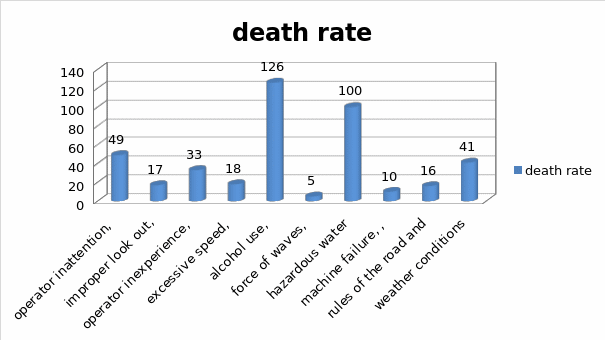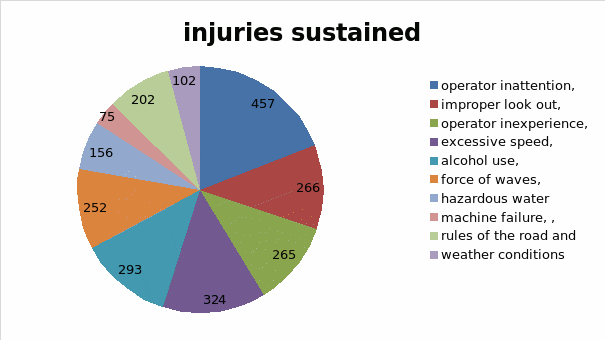Introduction
The main aim of this report is to find out the number of accidents that occurred in the year 2010 in the recreational boating services in US. The accidents has been grouped into various categories which includes; collision with recreational vessels, collision with fixed objects, flooding /swamping, capsizing and skier mishap and their contributing factors such as; operator inattention, improper look out, operator inexperience, excessive speed, alcohol use, force of waves, machine failure, weather conditions, rules of the road and hazardous water. The number of deaths resulting from the accidents will be analyzed and proper conclusion and recommendation will be made.
Data sources
The data used in this case has been obtained from US department of homeland security. The data relates to recreational boats accidents. This data is shown in the table below
Primary accident types
Contributing factors of accidents
Analysis
Operator inattention contributed to the large number of accidents, which claimed 49 lives. However, alcohol use contributed to a larger number of deaths. The graph below shows the number of deaths that occurred due to various contributing factors.

From the graph above most deaths occurred in alcohol use, followed by hazardous water, then operator inattention and then operator inexperience. Weather conditions also played a significant role in the accidents that took place in the boating services. For instance, 41% of the deaths are attributed to it. Alcohol use contributed to 30% of all deaths that occurred during the year. Factors linked to the operator include; operator inattention, improper lookout, operator inexperience, excessive speed, alcohol use, contributed to almost 60% of all deaths. These rates are having been shown in the table below.
Human contributing factor death rate = 243/415
=58.55%
The largest number of injuries sustained, is mostly due to human error which would have been controlled and thus prevent death and injuries. Over 60% of all injuries were contributed by the operator actions or situations by being inattentive, inexperienced, over speeding, using alcohol and having improper lookout. In total, there were 1605 injuries sustained due to these human errors. Machine failure and hazardous water are considered among the factors beyond human control, though they contributed to less than 33% of all injuries. The table below shows the injuries sustained due to the contribution of the operator:
The rate of injuries sustained due to operator contributions = 1605/2392 =67.1%
The pie chart below shows the contributing factors and the number of injuries sustained.

Discussion
Carelessness among individuals with responsibility in an organization usually results to Accidents. This happens in a scenario where an individual not having the concern of what a certain action s/he might end up resulting to. For example, assumptions of simple guidance in the operation or capacity of something, negligence of an individual under an affected area, Engineering or other technological mishaps, majorly in building sites, Ones behavior, say, lack of self control and ill willing, is also a precursor of failure thus causing death or injurious cases. Such cases may include the explosion of electrical connections and switches, abandoning doors and/or windows to restricted areas and so on.
In this case, it appears that operator inattention caused serious accident but their collision was not very severe to cause more deaths as in the case of alcohol abuse and hazardous water. In the case of alcohol use the operator losses focus, he can over speed, loss attention as well as have improper lookout that is why the impact of the accident is very high in terms of the number of deaths and injuries sustained. This means that the operator losses focus and makes errors in judgment. Assumptions of simple guidance in the operation or capacity of something is an event where Instructions based on capacity and procedural once looked down upon might result into alarming situations. Like in our case, the impact of collision relating to operator contributing factors appears to have a higher impact because more people are killed while others sustain serious injuries. This occurs due to the strain or pressure and a system or site undergoes due to being run in a manner its instructions go against it.
Engineering or other technological mishaps, majorly of boats are another event. The structure gives way after being under pressure in various ways such as inadequate material. Accidents of this nature are usually unexpected and sudden, causing death, and loss of property. However, like in this case, accidents caused by factors that are beyond human control are unpredictable and their impact is minimal unless it is in hazardous water. In this case, the owners of the vessels are required to advice the operator not to venture into such waters, which include acidic waters. Support is usually a key aspect in the event of making something be fulfilled, especially from a resourceful partner. In the case of a deficiency of this, a system has a high likelihood of failing because for anything to happen to its optimal expectation and resources are usually needed. Monetary matters can also be a good insight of judging about an impending failure. Poor budgetary of a certain activity, on issues that call for the expenditure is a sign of an impending failure. The shifting of objectives of a former original objective in a project or activity is also a tip-off of impending failure.
Unrealistic deadlines are another early recognizable sign that can warn of failure. Having the deadline of the completion being set too soon can cause inadequate focus on minute details of certain aspects.
Limitations
The data relied upon can be insufficient because some people may have not reported some minor accidents due to fear of prosecution.
The government relied on the reported cases only, which may not give a proper picture for recommendation.
In the analysis of this case, generalization has been made to all cases.
There was little time to curry out adequate secondary research to make an informed decision related to the data corrected.
Assumptions
It is assumed that all accident cases were reported with their respective causes and data correctly recorded.
The reported cases are assumed to cover the whole nations’ boating services.
Conclusion and recommendation
Negligence of an individual under an affected area is a major event that might end up leading to an Accident. This usually starts with very minute and avoidable issues, whereby one will assume a small error or a temporal failure of a certain system. Such ‘minute’ errors might significantly magnify to produce a life and property losing Accidents (Rivkind, 1).
Operator conditions before and during driving is very important strict rules should be put be in place to ensure that the operator is not under the influence of alcohol before driving the boat. The state of health of the operator especially fatigue should be considered before he is given a boat to drive tourist. This is because most accidents have occurred because of the operators’ errors in judgment. The operator can over speed, have casual lookout, be not attentive because of fatigue. A safety manual should be given to each operator to guide him during the course of his work. These manuals contain a list of common accidents in that specific environment and the means and methods to avoid these accidents. In some work place environments, the manuals are printed in booklet form and it is mandatory for every worker to keep that booklet at their person (Tomczuk and Maxim, 2).
Regular drills should be conducted in order to familiarize their operators with the safety procedures. Drills also prepare them on how to react in case of an emergency and how to conduct their affair from thereafter. Regular Checks should be conducted to ensure that the operators are following the safety procedures mentioned.
Works Cited
Cook, Kevin. “Recreational boating statistics 2010.” US department of homeland security office of auxiliary and boating safety. 2011. Web.
Rivkind, Brett. “Recreational Boating Statistics of 2010 Reveal 4,604 Accidents and 672 Deaths.” The law of the sea. 2011. Web.
Tomczuk, Susan, and Maxim, Daniel. “Recreational Boating Accident Statistics and Trends.” Proceedings. 2011. Web.